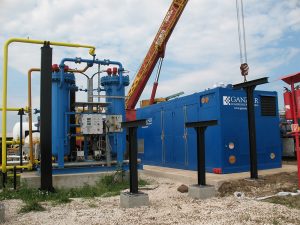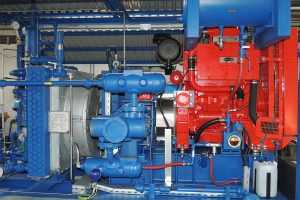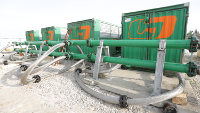
Gas transmission pipeline evacuation compressors
A fully-automated, self-sustaining compressor systems for the evacuation of natural gas from pipelines as part of the maintenance and repair measures. According to the project-specific rating, the remaining pressure in the pipeline can be lowered to 5 bar. This will drastically reduce natural gas emissions into the atmosphere.
In order to achieve a minimum of residual pressure, the systems come with a patented, automated switch between one- and two-stage compressor operations. The compressor aggregate is driven by a gas engine, in order to use the gas available in the pipeline and to avoid the necessity of an additional energy source.
On customer’s request, the system is integrateable with other components to meet the special applications. The range of job can determine the size of the compressor. Usually the compressor is mobilized (trailer mounted or skid mounted), because the application type.

Gas gathering booster compressor units
A gathering and boosting station collects gas from multiples wells and moves it toward the natural gas processing plant or gas pipeline. The discharge pressure depends on the recieving station (eg. 63 bar).
Usually the gathering booster compressors are skid mounted or containerized, portable units to help to relocate them, but in the large sites have stationary units.
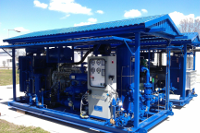
Wellhead compressor units
It is not always possible to install centralized compression, and a single wellhead compressor might be necessary for production. Even with a compressor, wells still might experience liquid loading. To alleviate this problem, a plunger system can be installed in conjunction with wellhead compression. With a gas-engine-driven compressor, the installation is could be difficult.
A gas compressor cannot easily be automated to start and stop, so it is desirable to keep the gas engine running during both the flowing and shut-in periods. When flowing, the compressor simply sends gas to the sales pipeline.
For shut-in periods, a bypass can be installed on the compressor that allows gas to circulate. The controller that operates the motor valve can be used to control an additional sales/bypass valve. To avoid potential problems with this setup, such as overheating of the circulating gas or insufficient supply gas to keep the compressor running, it is necessary to improve the cooling capacity of the compressor.
This type of compressors are designed to use under extreme conditions, commonly skid mounted with roof.
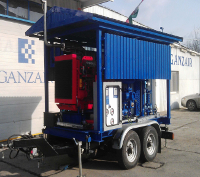
Well starter compressor units
This type of application is use the artificial lift technique of raising a fluid such as water or oil by introducing bubbles of gas bubbles into the outlet tube. This has the effect of reducing the hydrostatic pressure in the outlet tube vs. the hydrostatic pressure at the inlet side of the tube.
This kind of compressor should driven by diesel engine to operate next to a “dead” gas well, far away from any distribution system. After well start up, the well can work without compressor or with wellhead compressor.
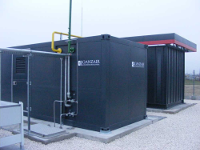
CNG filling compressors
The CNG is made by compressing Natural Gas. The inlet pressure of the compressor can be from 0,03 barg, the outlet pressure usually 250 bar. Nowadays the gas can be Biogas.
The compressors are plug&play and easy to install. Integrated design including pre-piped pulsation dampeners cum separators, blowdown vessels, suction and discharge filters and non return valve ensure that the installations are designed to promote safety features.
The compressor can equipped with dryer, heater or cooler.


